THz Range Low-Noise SIS Receivers for Space and Ground-Based Radio Astronomy †
Abstract
:Featured Application
Abstract
1. Introduction
2. Materials and Methods
2.1. Nb/AlOx/Nb and Nb/AlN/NbN SIS Mixers
2.2. Mixer and Mixer Block Designs
3. Experimental Results
3.1. 211–275 GHz SIS-Mixer Measurements
3.2. High Band (790–950 GHz) Mixers
4. Conclusions
Author Contributions
Funding
Conflicts of Interest
References
- Zmuidzinas, J.; Richards, P.L. Superconducting detectors and mixers for millimeter and submillimeter astrophysics. Proc. IEEE 2004, 92, 1597–1616. [Google Scholar] [CrossRef] [Green Version]
- Sizov, F.; Rogalski, A. THz detectors. Prog. Quantum Electron. 2010, 34, 278–347. [Google Scholar] [CrossRef]
- Tucker, J.R. Quantum Limited Detection in Tunnel Junction Mixers. IEEE J. Quantum Electron. 1979, 15, 1234–1258. [Google Scholar] [CrossRef]
- Tucker, J.R.; Feldman, M.J. Quantum Detection at millimeter wavelengths. Rev. Mod. Phys. 1985, 57, 1055–1113. [Google Scholar] [CrossRef]
- Richards, P.L.; Shen, T.M.; Harris, R.E.; Lloyd, F.L. Quasiparticle heterodyne mixing in SIS tunnel junctions. Appl. Phys. Lett. 1979, 34, 345–347. [Google Scholar] [CrossRef]
- Kerr, A.R.; Feldman, M.J.; Pan, S.-K. Receive Noise Temperature, the Quantum Noise Limit, and the Role of the Zero-Point Fluctuations. In Proceedings of the Eighth International Symposium on Space Terahertz Technology, Cambridge, MA, USA, 25–27 March 1997. [Google Scholar]
- Semenov, A.D.; Gol’tsman, G.N.; Sobolewski, R. Hot-electron effect in superconductors and its applications for radiation sensors. Supercond. Sci. Technol. 2002, 15, R1–R16. [Google Scholar] [CrossRef]
- Shurakov, A.; Lobanov, Y.; Goltsman, G. Superconducting hot-electron bolometer: From the discovery of hot-electron phenomena to practical applications. Supercond. Sci. Technol. 2016, 29, 1–27. [Google Scholar] [CrossRef]
- Gao, J.R.; Hovenier, J.N.; Yang, Z.Q.; Baselmans, J.J.A.; Baryshev, A.; Hajenius, M.; Klapwijk, T.M.; Adam, A.J.; Klaassen, T.O.; Williams, B.S.; et al. A terahertz heterodyne receiver based on a quantum cascade laser and a superconducting bolometer. Appl. Phys. Lett. 2005, 86, 244104. [Google Scholar] [CrossRef] [Green Version]
- Cherednichenko, S.; Drakinskiy, V.; Berg, T.; Khosropanah, P.; Kollberg, E. Hot-electron bolometer terahertz mixers for the Herschel Space Observatory. Rev. Sci. Instrum. 2008, 79, 034501. [Google Scholar] [CrossRef]
- Maezawa, H. Application of Superconducting Hot-Electron Bolometer Mixers for Terahertz-Band Astronomy. IEICE Trans. Electron. 2015, E98, 196–206. [Google Scholar] [CrossRef] [Green Version]
- De Graauw, T.; Helmich, F.P.; Phillips, T.G.; Stutzki, J.; Caux, E.; Whyborn, N.D.; Dieleman, P.; Roelfsema, P.R.; Aarts, H.; Assendorp, R.; et al. The Herschel—Heterodyne Instrument for the Far-Infrared (HIFI). Astron. Astrophys. 2010, 518, 1–7. [Google Scholar] [CrossRef] [Green Version]
- Available online: https://www.almaobservatory.org/en/about-alma-at-first-glance/how-alma-works/technologies/interferometry/ (accessed on 19 September 2021).
- Available online: https://www.iram-institute.org/EN/content-page-56-7-56-0-0-0.html (accessed on 19 September 2021).
- Available online: https://www.eso.org/public/teles-instr/apex/ (accessed on 19 September 2021).
- Koshelets, V.P.; Shitov, S.V. Integrated Superconducting Receivers. Supercond. Sci. Technol. 2000, 13, R53–R69. [Google Scholar] [CrossRef] [Green Version]
- De Lange, G.; Birk, M.; Boersma, D.; Dercksen, J.; Dmitriev, P.; Ermakov, A.; Filippenko, L.; Golstein, H.; Hoogeveen, R.; de Jong, L.; et al. Development and characterization of the superconducting integrated receiver channel of the TELIS atmospheric sounder. Supercond. Sci. Technol. 2010, 23, 045016. [Google Scholar] [CrossRef]
- Li, M.; Yuan, J.; Kinev, N.; Li, J.; Gross, B.; Guénon, S.; Ishii, A.; Hirata, K.; Hatano, T.; Koelle, D.; et al. Linewidth dependence of coherent terahertz emission from Bi2Sr2CaCu2O8 intrinsic Josephson junction stacks in the hot-spot regime. Phys. Rev. B 2012, 86, 060505. [Google Scholar] [CrossRef] [Green Version]
- Baksheeva, K.; Ozhegov, R.; Goltsman, G.; Kinev, N.; Koshelets, V.; Kochnev, A.; Betzalel, N.; Puzenko, A.; Ishai, P.; Feldman, Y. The Sub THz Emission of the Human Body under Physiological Stress. IEEE Trans. Terahertz Sci. Technol. 2021, 11, 381–388. [Google Scholar] [CrossRef]
- Available online: http://millimetron.ru/index.php/en/ (accessed on 19 September 2021).
- Andrianov, A.S.; Baryshev, A.M.; Falcke, H.; Girin, I.A.; de Graauw, T.; Kostenko, V.I.; Kudriashov, V.; Ladygin, V.A.; Likhachev, S.F.; Roelofs, F.; et al. Simulations of M87 and Sgr A* imaging with the Millimetron Space Observatory on near-Earth orbits. Mon. Not. R. Astron. Soc. 2021, 500, 4866–4877. [Google Scholar] [CrossRef]
- Kasemann, C.; Güsten, R.; Heyminck, S.; Klein, B.; Klein, T.; Philipp, S.D.; Korn, A.; Schneider, G.; Henseler, A.; Baryshev, A.; et al. CHAMP+: A powerful array receiver for APEX. Millim. Submillimeter Detect. Instrum. Astron. III 2006, 6275, 62750N. [Google Scholar] [CrossRef] [Green Version]
- Güsten, R.; Booth, R.S.; Cesarsky, C.; Menten, K.M.; Agurto, C.; Anciaux, M.; Wyrowski, F. Ground-based and Airborne Telescopes. Int. Soc. Opt. Photonics 2006, 6267, 626714. [Google Scholar]
- Baryshev, A.M.; Hesper, R.; Mena, F.P.; Klapwijk, T.M.; van Kempen, T.A.; Hogerheijde, M.R.; Jackson, B.D.; Adema, J.; Gerlofsma, G.J.; Bekema, M.E.; et al. The ALMA Band 9 receiver. Design, construction, characterization, and first light. Astron. Astrophys. 2015, 577, A129. [Google Scholar] [CrossRef] [Green Version]
- Rowell, J.M.; Gurvitch, M.; Geerk, J. Modification of tunneling barriers on Nb by a few monolayers of Al. Phys. Rev. B 1981, 24, 2278–2281. [Google Scholar] [CrossRef]
- Gurvitch, M.; Washington, M.A.; Huggins, H.A. High quality refractory Josephson tunnel junctions utilizing thin aluminum layers. Appl. Phys. Lett. 1983, 42, 472–474. [Google Scholar] [CrossRef]
- Imamura, T.; Shiota, T.; Hasuo, S. Fabrication of high quality Nb/AlOx-Al/Nb Josephson junctions: I—Sputtered Nb films for junction electrode. IEEE Trans. Appl. Supercond. 1992, 2, 222–227. [Google Scholar]
- Dmitriev, P.N.; Ermakov, A.B.; Kovalenko, A.G.; Koshelets, V.P.; Iosad, N.N.; Golubov, A.A.; Kupriyanov, M.Y. Niobium tunnel junctions with multi-layered electrodes. IEEE Trans. Appl. Supercond. 1999, 9, 3970–3973. [Google Scholar] [CrossRef]
- Filippenko, L.V.; Shitov, S.V.; Dmitriev, P.N.; Ermakov, A.B.; Koshelets, V.P.; Gao, J.R. Submillimeter superconducting integrated receivers: Fabrication and yield. IEEE Trans. Appl. Supercond. 2001, 11, 816–819. [Google Scholar] [CrossRef] [Green Version]
- Dmitriev, P.N.; Lapitskaya, I.L.; Filippenko, L.V.; Ermakov, A.B.; Shitov, S.V.; Prokopenko, G.V.; Kovtonyuk, S.A.; Koshelets, V.P. High quality Nb-based tunnel junctions for high frequency and digital applications. IEEE Trans. Appl. Supercond. 2003, 13, 107–110. [Google Scholar] [CrossRef] [Green Version]
- Golubov, A.A.; Houwman, E.P.; Gijsbertsen, J.G.; Krasnov, V.M.; Flokstra, J.; Rogalla, H.; Kupriyanov, M.Y. Proximity effect in superconductor-insulator-superconductor Josephson tunnel junctions: Theory and experiment. Phys. Rev. B 1995, 51, 1073–1089. [Google Scholar] [CrossRef]
- Shiota, T.; Imamura, T.; Hasuo, S. Nb Josephson junction with an AlNx barrier made by plasma nitridation. Appl. Phys. Lett. 1992, 61, 1228–1230. [Google Scholar] [CrossRef]
- Kleinsasser, A.W.; Miller, R.E.; Mallison, W.H. Nb/AIN/Nb Josephson Junctions with High Critical Current Density. IEEE Trans. Appl. Supercond. 1995, 5, 2318–2321. [Google Scholar] [CrossRef]
- Kawamura, J.; Miller, D.; Chen, J.; Zmuidzinas, J.; Bumble, B.; LeDuc, H.G.; Stern, J.A. Very high-current-density Nb/AlN/Nb tunnel junctions for low-noise submillimeter mixers. Appl. Phys. Lett. 2000, 76, 2119–2121. [Google Scholar] [CrossRef] [Green Version]
- Bumble, B.; LeDuc, H.G.; Stern, J.A.; Megerian, K.G. Fabrication of Nb/Al-Nx/NbTiN junctions for SIS mixer applications. IEEE Trans. Appl. Supercond. 2001, 11, 76–79. [Google Scholar] [CrossRef]
- Jackson, B.D.; de Lange, G.; Zijlstra, T.; Kroug, M.; Klapwijk, T.M.; Stern, J.A. Niobium titanium nitride-based superconductor-insulator-superconductor mixers for low-noise terahertz receivers. J. Appl. Phys. 2005, 97, 113904. [Google Scholar] [CrossRef] [Green Version]
- Karpov, A.; Miller, D.; Rice, F.; Stern, J.A.; Bumble, B.; LeDuc, H.G.; Zmuidzinas, J. Low Noise 1 THz–1.4 THz Mixers Using Nb/Al-AlN/NbTiN SIS Junctions. IEEE Trans. Appl. Supercond. 2007, 17, 343–346. [Google Scholar] [CrossRef]
- Uzawa, Y.; Fujii, Y.; Gonzalez, A.; Kaneko, K.; Kroug, M.; Kojima, T.; Miyachi, A.; Makise, K.; Saito, S.; Terai, H.; et al. Tuning circuit material for mass-produced terahertz SIS receivers. IEEE Trans. Appl. Supercond. 2015, 25, 1–5. [Google Scholar] [CrossRef]
- Khudchenko, A.; Baryshev, A.M.; Rudakov, K.I.; Dmitriev, P.M.; Hesper, R.; de Jong, L.; Koshelets, V.P. High-Gap Nb-AlN-NbN SIS Junctions for Frequency Band 790-950 GHz. IEEE Trans. Terahertz Sci. Technol. 2016, 6, 127–132. [Google Scholar] [CrossRef]
- Shapiro, S. Josephson Currents in Superconducting Tunneling: The Effect of Microwaves and Other Observations. Phys. Rev. Lett. 1963, 11, 80–82. [Google Scholar] [CrossRef]
- Torgashin, M.Y.; Koshelets, V.P.; Dmitriev, P.N.; Ermakov, A.B.; Filippenko, L.V.; Yagoubov, P.A. Superconducting integrated receiver based on Nb-AlN-NbN-Nb circuits. IEEE Trans. Appl. Supercond. 2007, 17, 379–382. [Google Scholar] [CrossRef]
- Dmitriev, P.N.; Filippenko, L.V.; Koshelets, V.P. Applications in Superconducting SIS Mixers and Oscillators: Toward Integrated Receivers. In Josephson Junctions, History, Devices, and Applications; Wolf, E., Arnold, G., Gurvitch, M., Zasadzinski, J., Eds.; Pan Stanford Publishing Pte: Singapore, 2017; pp. 185–244. ISBN1 978-981-4745-47-5 (Hardcover). ISBN2 978-1-315-36452-0 (eBook). [Google Scholar]
- Paramonov, M.E.; Filippenko, L.V.; Dmitriev, P.N.; Fominsky, M.Y.; Ermakov, A.B.; Koshelets, V.P. Parameters of the Tunnel Barrier of Superconducting Niobium-Based Structures. Phys. Solid State 2020, 62, 1534–1538. [Google Scholar] [CrossRef]
- Simmons, J.G. Generalized Formula for the Electric Tunnel Effect between Similar Electrodes Separated by a Thin Insulating Film. J. Appl. Phys. 1963, 34, 1793–1803. [Google Scholar] [CrossRef] [Green Version]
- Brinkman, W.F.; Dynes, R.C.; Rowell, J.M. Tunneling conductance of asymmetrical barriers. J. Appl. Phys. 1970, 41, 1915–1921. [Google Scholar] [CrossRef] [Green Version]
- LeDuc, H.G.; Stern, J.A.; Cypher, S.R. Two-Junction Tuning Circuits for Submillimeter SIS Mixers. IEEE Trans. Microw. Theory Tech. 1994, 42, 698–706. [Google Scholar] [CrossRef]
- Belitsky, V.Y.; Jacobsson, S.W.; Filippenko, L.V.; Kollberg, E.L. Broadband twin-junction tuning circuit for submillimeter SIS mixers. Microw. Opt. Technol. Lett. 1995, 10, 74–78. [Google Scholar] [CrossRef]
- Rudakov, K.I.; Dmitriev, P.N.; Baryshev, A.M.; Khudchenko, A.V.; Hesper, R.; Koshelets, V.P. Low-Noise SIS Receivers for New Radio-Astronomy Projects. Radiophys. Quantum Electron. 2019, 62, 547–555. [Google Scholar] [CrossRef]
- Rudakov, K.I. Development of Advanced Superconductor-Insulator-Superconductor Mixers for Terahertz Radio Astronomy. Ph.D. Thesis, University of Groningen, Groningen, The Netherlands, 2021. [Google Scholar]
- Rudakov, K.I.; Koshelets, V.P.; Baryshev, A.M.; Dmitriev, P.N.; Khudchenko, A.V. The 700–950 GHz Superconducting Receiving Structures for Radio Astronomy. Radiophys. Quantum Electron. 2017, 59, 711–714. [Google Scholar] [CrossRef]
- Khudchenko, A.; Baryshev, A.M.; Hesper, R.; Bekema, M.E.; De, R.; Stijkel, H.; Barkhof, J.; van Nguyen, D.; Koshelets, V.P.; Dmitriev, P.; et al. Performance of SIS mixers for upgrade of CHAMP+ 7-pixel arrays. In Proceedings of the International Symposium on Space Terahertz Technology ISSTT-2017, Cologne, Germany, 13–15 March 2017; pp. 87–90. [Google Scholar]
- Otarola, A.; Holdaway, M.; Nyman, L.E.; Radford, S.J.E.; Butler, B.J. Atmospheric Transparency at Chajnantor: 1973–2003, ALMA Memo Series, Memo 512. 2005. Available online: http://library.nrao.edu/alma.shtml (accessed on 19 September 2021).
- Available online: http://asc-lebedev.ru/index2.php?engdep=16&engsuffa=4 (accessed on 19 September 2021).
- Available online: https://www.llamaobservatory.org/en/ (accessed on 19 September 2021).
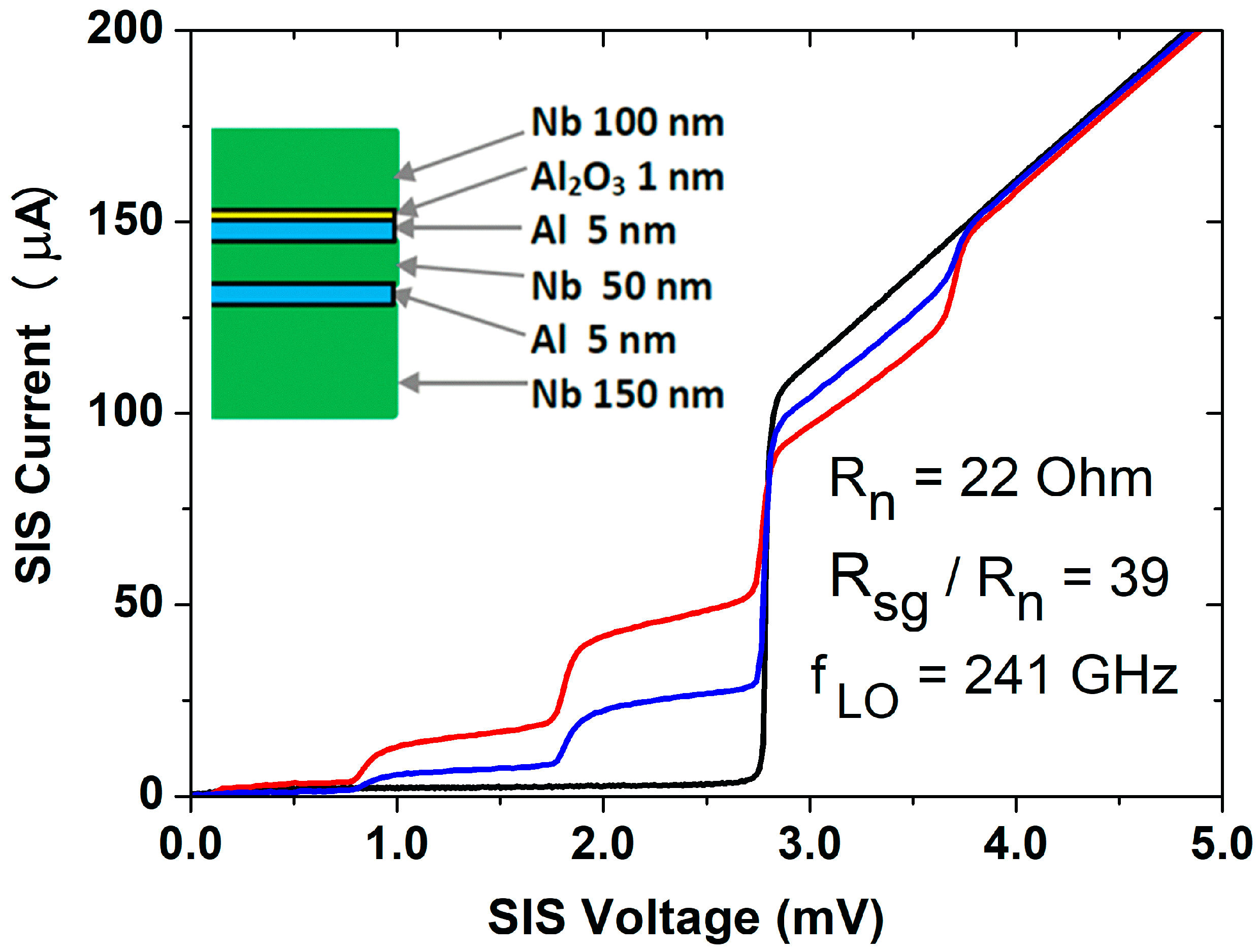
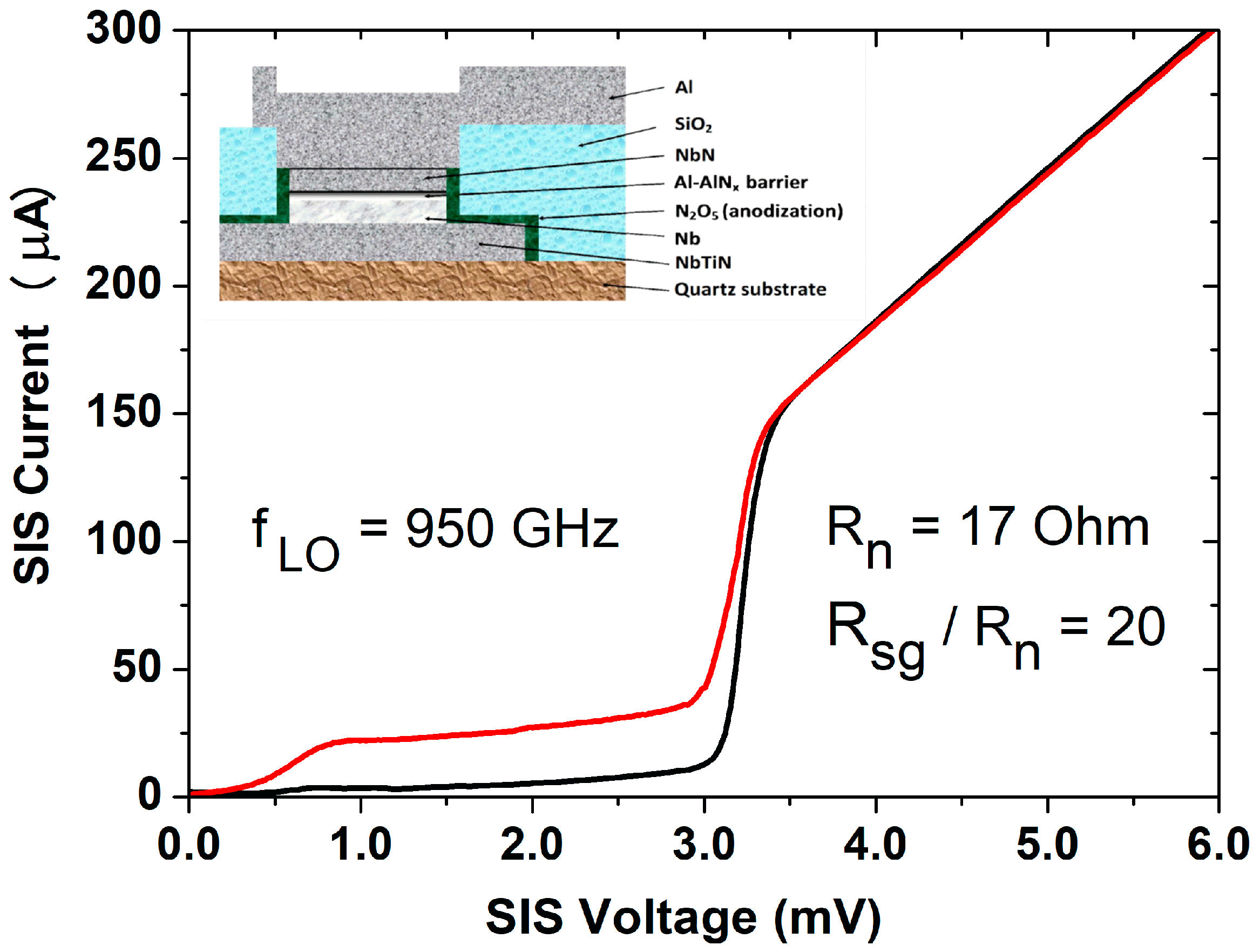
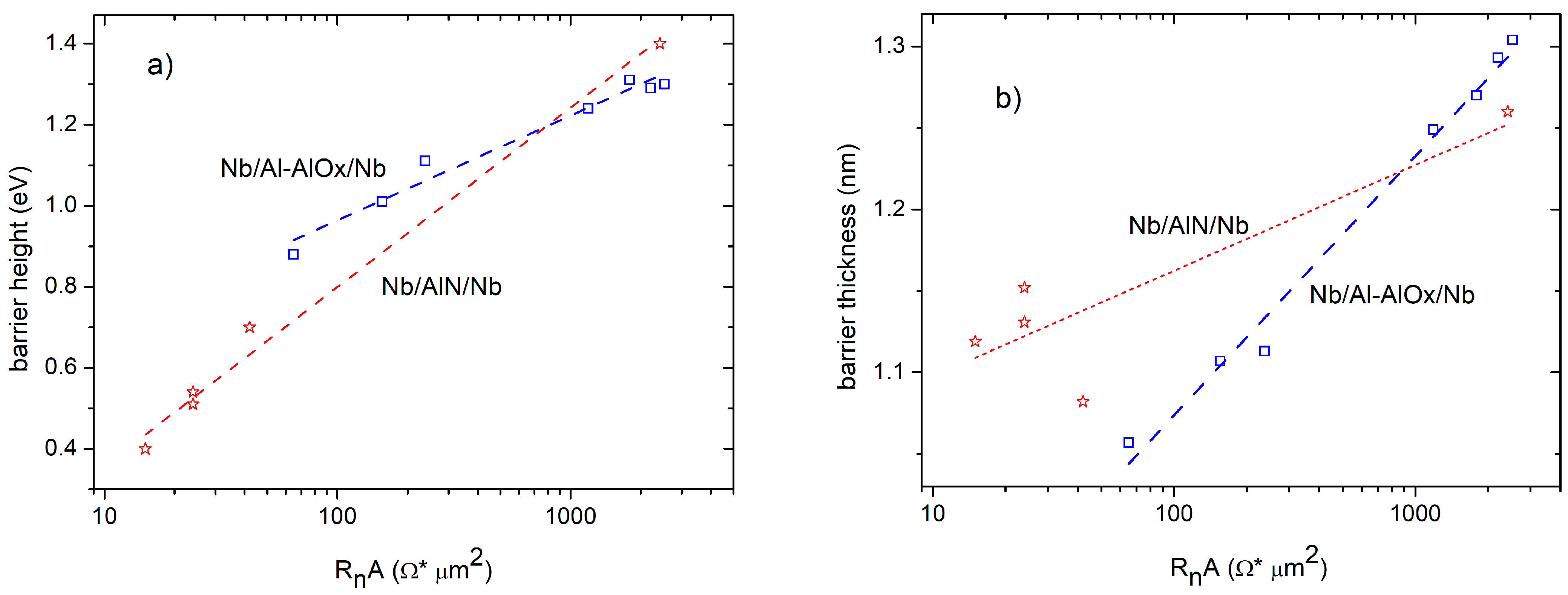


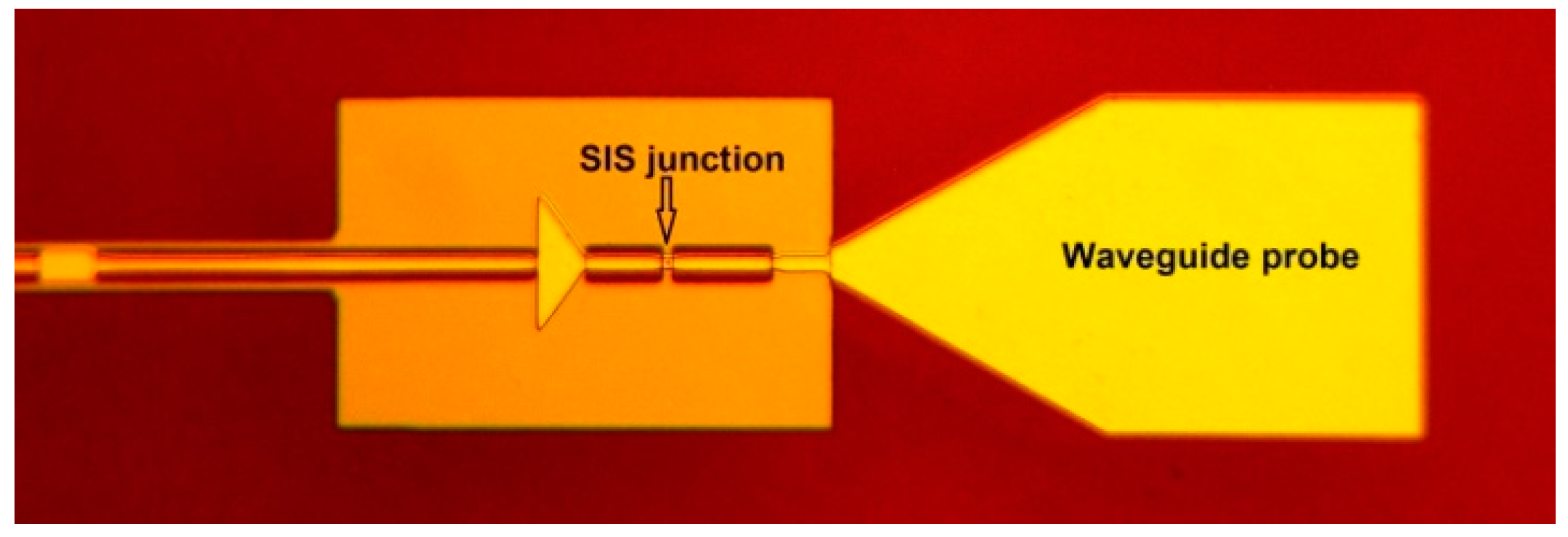
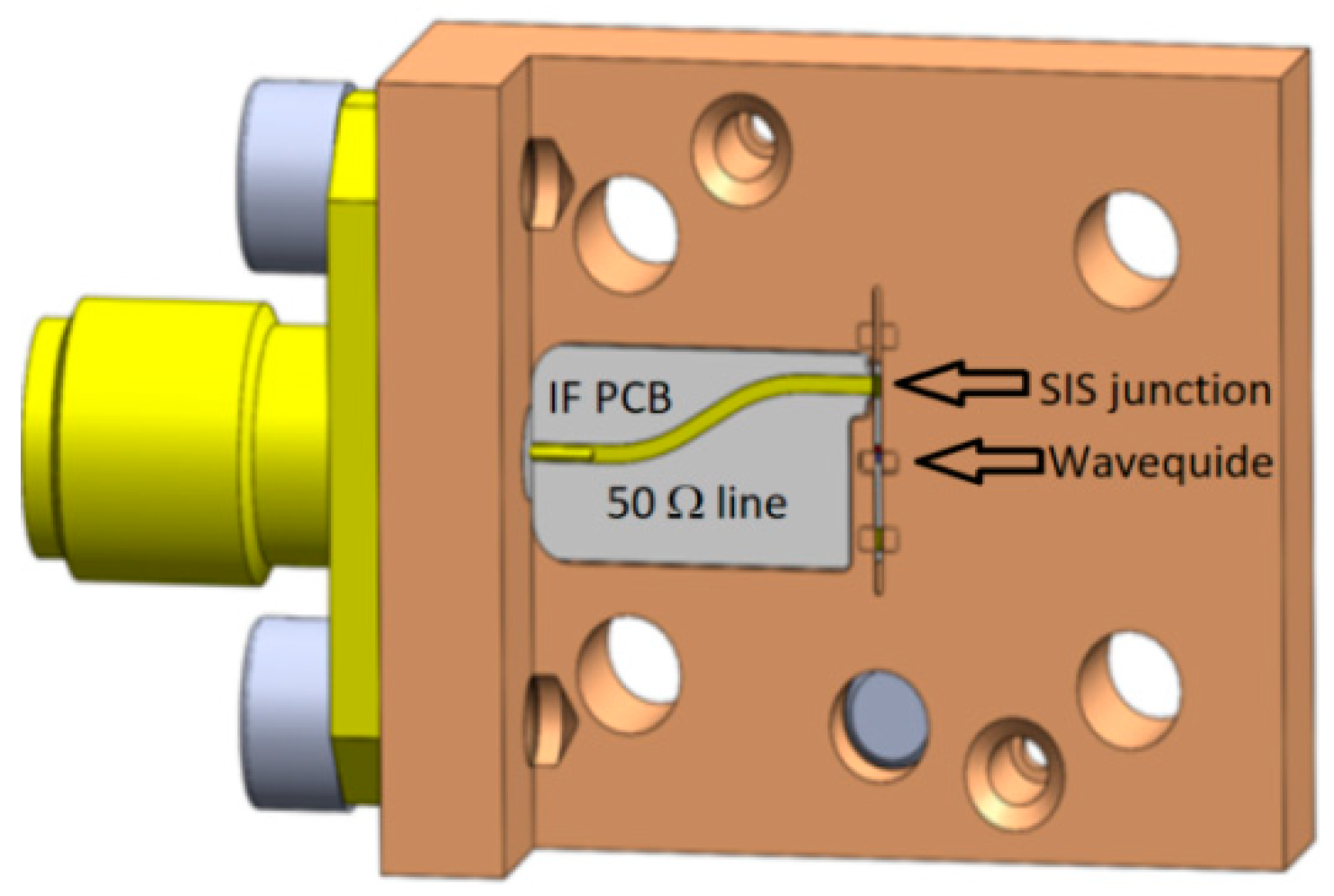



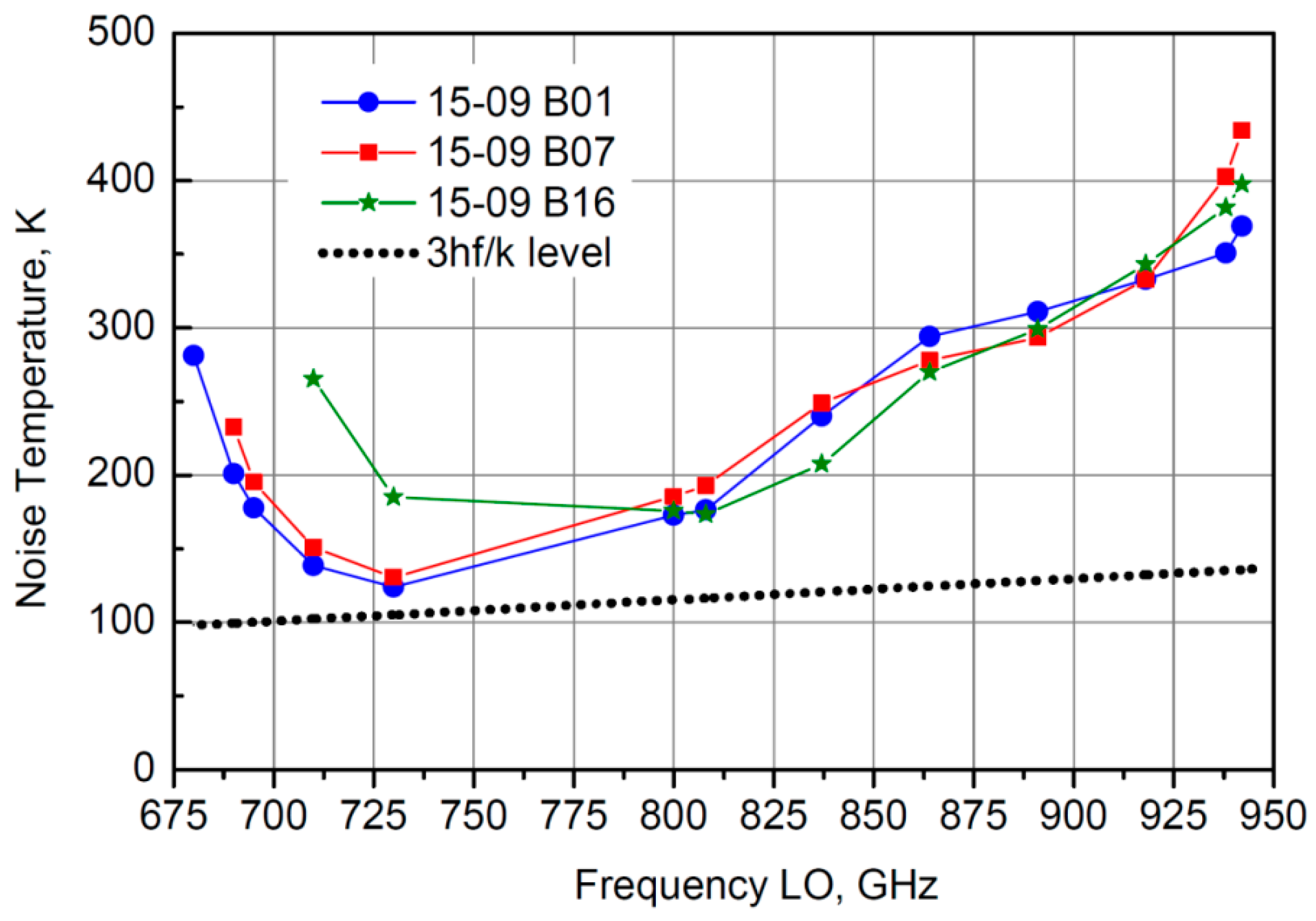

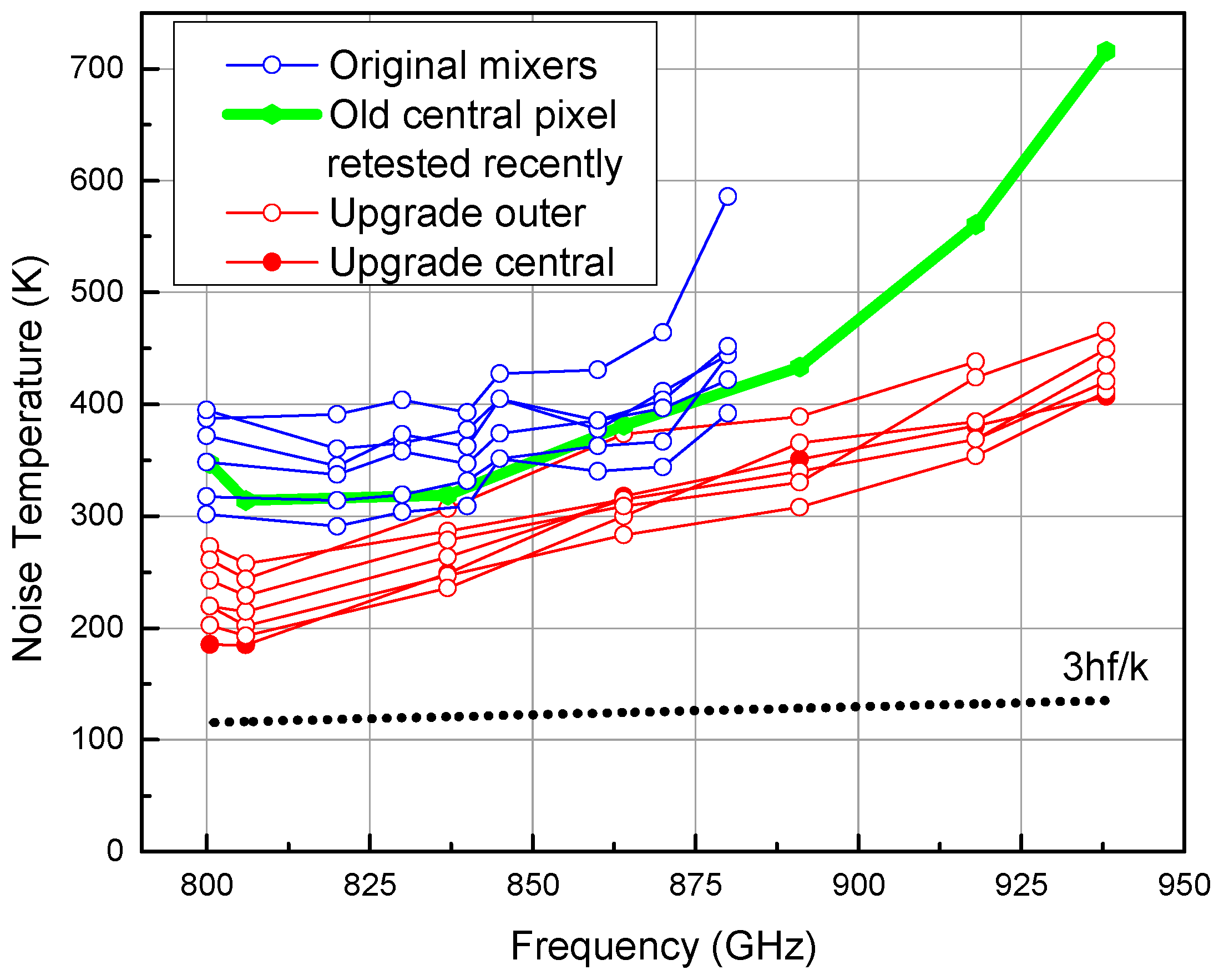
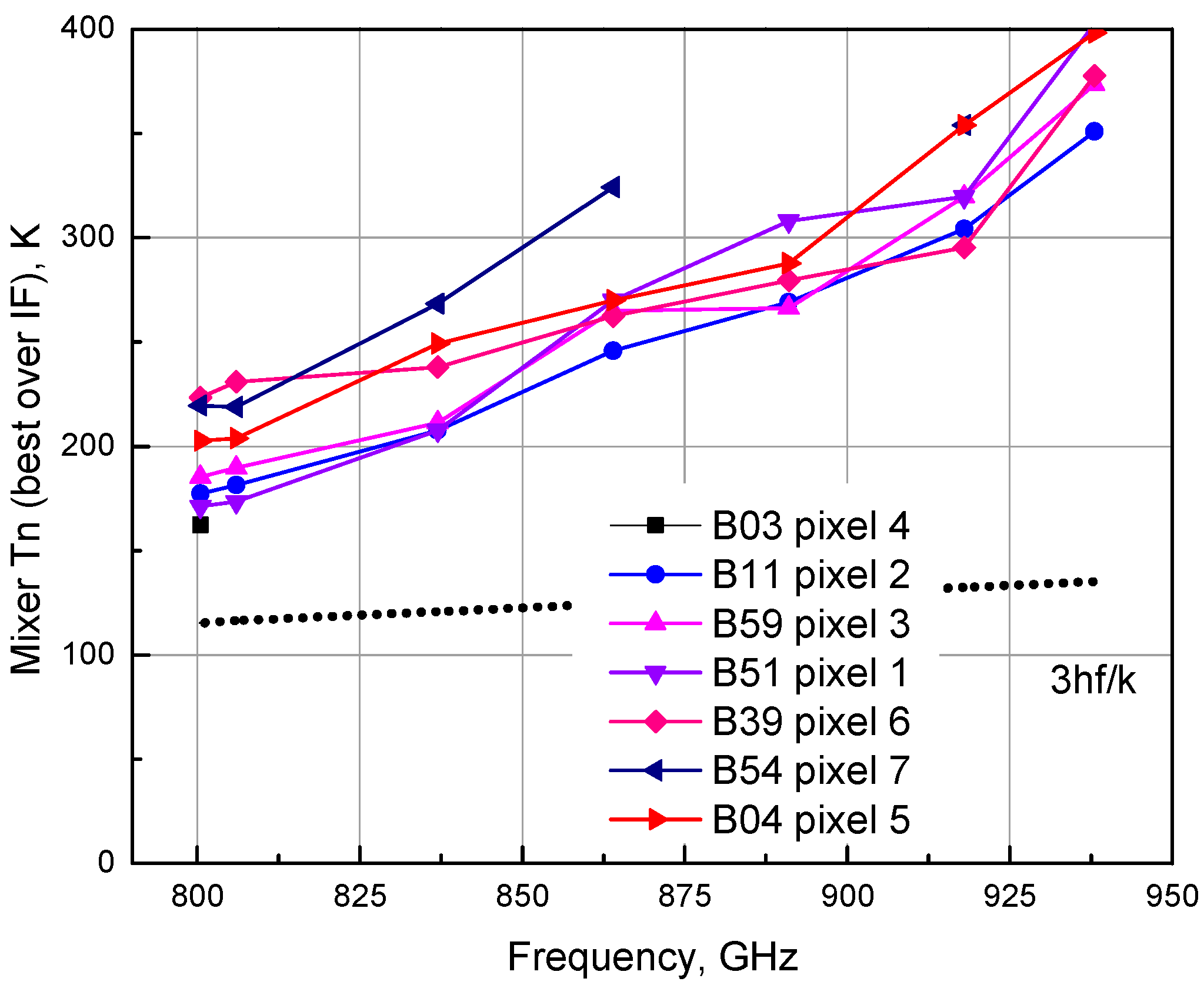
Publisher’s Note: MDPI stays neutral with regard to jurisdictional claims in published maps and institutional affiliations. |
© 2021 by the authors. Licensee MDPI, Basel, Switzerland. This article is an open access article distributed under the terms and conditions of the Creative Commons Attribution (CC BY) license (https://creativecommons.org/licenses/by/4.0/).
Share and Cite
Rudakov, K.I.; Khudchenko, A.V.; Filippenko, L.V.; Paramonov, M.E.; Hesper, R.; da Costa Lima, D.A.R.; Baryshev, A.M.; Koshelets, V.P. THz Range Low-Noise SIS Receivers for Space and Ground-Based Radio Astronomy. Appl. Sci. 2021, 11, 10087. https://doi.org/10.3390/app112110087
Rudakov KI, Khudchenko AV, Filippenko LV, Paramonov ME, Hesper R, da Costa Lima DAR, Baryshev AM, Koshelets VP. THz Range Low-Noise SIS Receivers for Space and Ground-Based Radio Astronomy. Applied Sciences. 2021; 11(21):10087. https://doi.org/10.3390/app112110087
Chicago/Turabian StyleRudakov, Kirill I., Andrey V. Khudchenko, Lyudmila V. Filippenko, Maxim E. Paramonov, Ronald Hesper, Daniele Aragão Ronsó da Costa Lima, Andrey M. Baryshev, and Valery P. Koshelets. 2021. "THz Range Low-Noise SIS Receivers for Space and Ground-Based Radio Astronomy" Applied Sciences 11, no. 21: 10087. https://doi.org/10.3390/app112110087
APA StyleRudakov, K. I., Khudchenko, A. V., Filippenko, L. V., Paramonov, M. E., Hesper, R., da Costa Lima, D. A. R., Baryshev, A. M., & Koshelets, V. P. (2021). THz Range Low-Noise SIS Receivers for Space and Ground-Based Radio Astronomy. Applied Sciences, 11(21), 10087. https://doi.org/10.3390/app112110087






